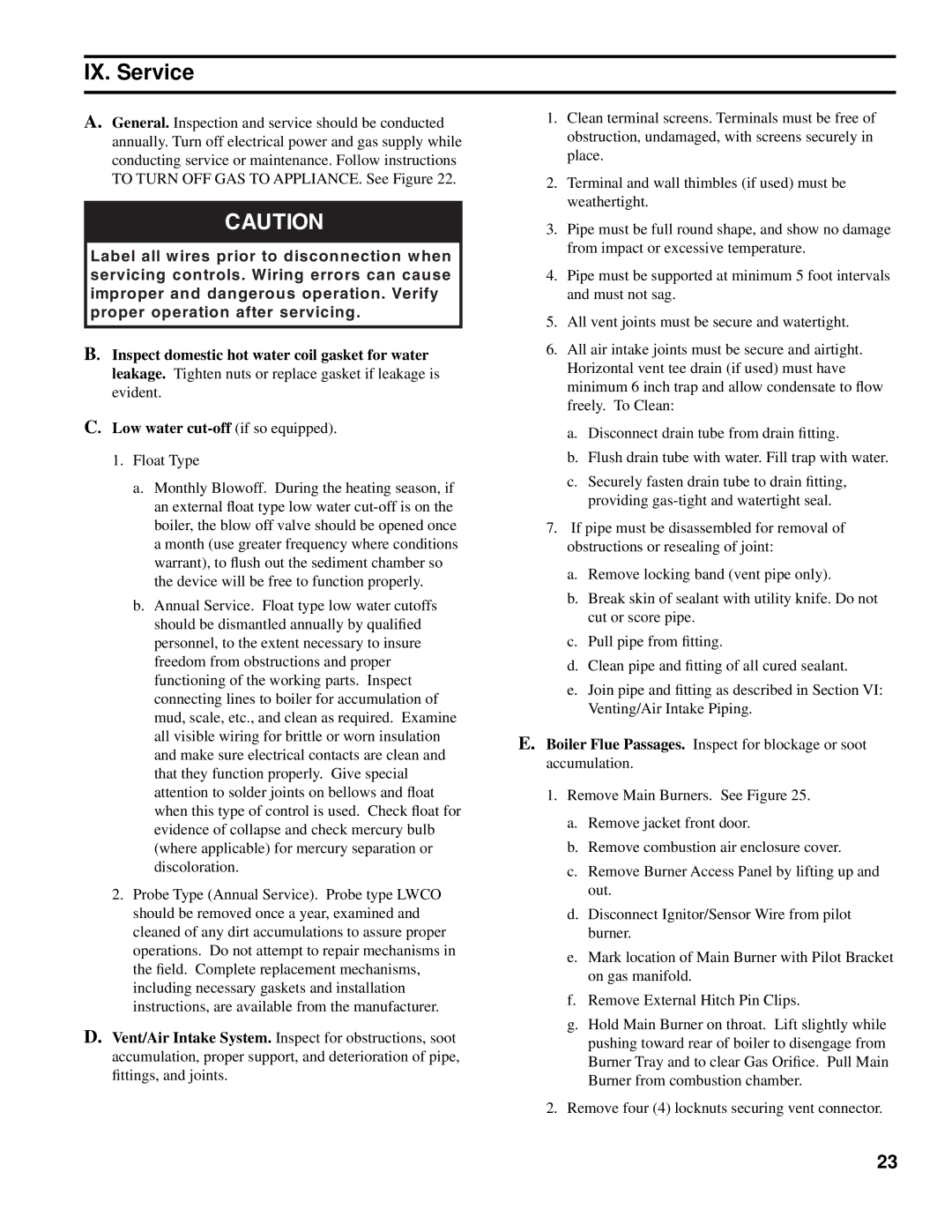
IX. Service
A.General. Inspection and service should be conducted annually. Turn off electrical power and gas supply while conducting service or maintenance. Follow instructions TO TURN OFF GAS TO APPLIANCE. See Figure 22.
CAUTION
Label all wires prior to disconnection when servicing controls. Wiring errors can cause improper and dangerous operation. Verify proper operation after servicing.
B. Inspect domestic hot water coil gasket for water leakage. Tighten nuts or replace gasket if leakage is evident.
C. Low water
1.Float Type
a.Monthly Blowoff. During the heating season, if an external float type low water
b.Annual Service. Float type low water cutoffs should be dismantled annually by qualified personnel, to the extent necessary to insure freedom from obstructions and proper functioning of the working parts. Inspect connecting lines to boiler for accumulation of mud, scale, etc., and clean as required. Examine all visible wiring for brittle or worn insulation and make sure electrical contacts are clean and that they function properly. Give special attention to solder joints on bellows and float when this type of control is used. Check float for evidence of collapse and check mercury bulb (where applicable) for mercury separation or discoloration.
2.Probe Type (Annual Service). Probe type LWCO should be removed once a year, examined and cleaned of any dirt accumulations to assure proper operations. Do not attempt to repair mechanisms in the field. Complete replacement mechanisms, including necessary gaskets and installation instructions, are available from the manufacturer.
D.Vent/Air Intake System. Inspect for obstructions, soot accumulation, proper support, and deterioration of pipe, fittings, and joints.
1.Clean terminal screens. Terminals must be free of obstruction, undamaged, with screens securely in place.
2.Terminal and wall thimbles (if used) must be weathertight.
3.Pipe must be full round shape, and show no damage from impact or excessive temperature.
4.Pipe must be supported at minimum 5 foot intervals and must not sag.
5.All vent joints must be secure and watertight.
6.All air intake joints must be secure and airtight. Horizontal vent tee drain (if used) must have minimum 6 inch trap and allow condensate to flow freely. To Clean:
a.Disconnect drain tube from drain fitting.
b.Flush drain tube with water. Fill trap with water.
c.Securely fasten drain tube to drain fitting, providing
7.If pipe must be disassembled for removal of obstructions or resealing of joint:
a.Remove locking band (vent pipe only).
b.Break skin of sealant with utility knife. Do not cut or score pipe.
c.Pull pipe from fitting.
d.Clean pipe and fitting of all cured sealant.
e.Join pipe and fitting as described in Section VI: Venting/Air Intake Piping.
E.Boiler Flue Passages. Inspect for blockage or soot accumulation.
1.Remove Main Burners. See Figure 25.
a.Remove jacket front door.
b.Remove combustion air enclosure cover.
c.Remove Burner Access Panel by lifting up and out.
d.Disconnect Ignitor/Sensor Wire from pilot burner.
e.Mark location of Main Burner with Pilot Bracket on gas manifold.
f.Remove External Hitch Pin Clips.
g.Hold Main Burner on throat. Lift slightly while pushing toward rear of boiler to disengage from Burner Tray and to clear Gas Orifice. Pull Main Burner from combustion chamber.
2.Remove four (4) locknuts securing vent connector.
23
